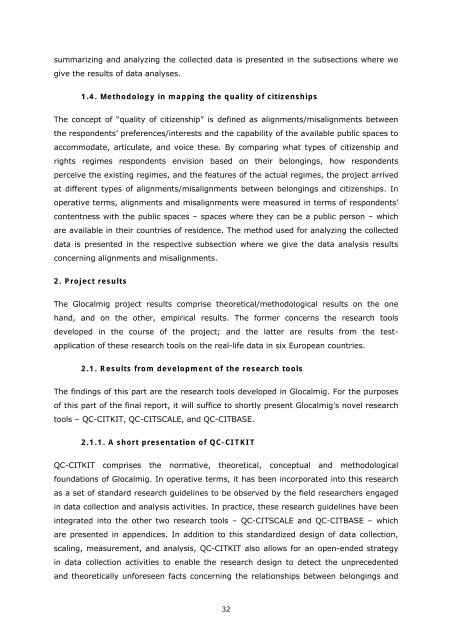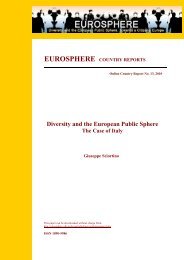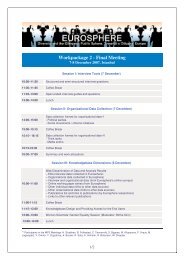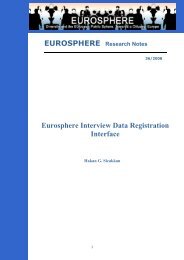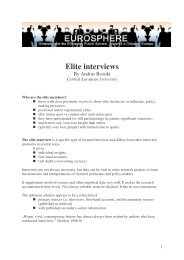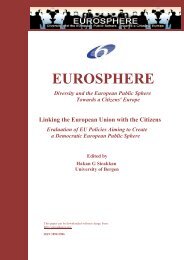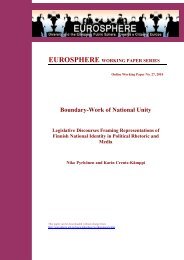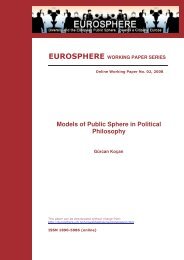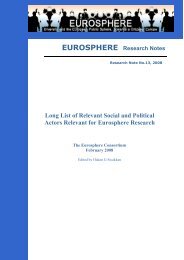Migrants, Minorities, Belongings and Citizenship. Glocalization and ...
Migrants, Minorities, Belongings and Citizenship. Glocalization and ...
Migrants, Minorities, Belongings and Citizenship. Glocalization and ...
You also want an ePaper? Increase the reach of your titles
YUMPU automatically turns print PDFs into web optimized ePapers that Google loves.
summarizing <strong>and</strong> analyzing the collected data is presented in the subsections where we<br />
give the results of data analyses.<br />
1.4. Methodology in mapping the quality of citizenships<br />
The concept of “quality of citizenship” is defined as alignments/misalignments between<br />
the respondents’ preferences/interests <strong>and</strong> the capability of the available public spaces to<br />
accommodate, articulate, <strong>and</strong> voice these. By comparing what types of citizenship <strong>and</strong><br />
rights regimes respondents envision based on their belongings, how respondents<br />
perceive the existing regimes, <strong>and</strong> the features of the actual regimes, the project arrived<br />
at different types of alignments/misalignments between belongings <strong>and</strong> citizenships. In<br />
operative terms, alignments <strong>and</strong> misalignments were measured in terms of respondents’<br />
contentness with the public spaces – spaces where they can be a public person – which<br />
are available in their countries of residence. The method used for analyzing the collected<br />
data is presented in the respective subsection where we give the data analysis results<br />
concerning alignments <strong>and</strong> misalignments.<br />
2. Project results<br />
The Glocalmig project results comprise theoretical/methodological results on the one<br />
h<strong>and</strong>, <strong>and</strong> on the other, empirical results. The former concerns the research tools<br />
developed in the course of the project; <strong>and</strong> the latter are results from the testapplication<br />
of these research tools on the real-life data in six European countries.<br />
2.1. Results from development of the research tools<br />
The findings of this part are the research tools developed in Glocalmig. For the purposes<br />
of this part of the final report, it will suffice to shortly present Glocalmig’s novel research<br />
tools – QC-CITKIT, QC-CITSCALE, <strong>and</strong> QC-CITBASE.<br />
2.1.1. A short presentation of QC-CITKIT<br />
QC-CITKIT comprises the normative, theoretical, conceptual <strong>and</strong> methodological<br />
foundations of Glocalmig. In operative terms, it has been incorporated into this research<br />
as a set of st<strong>and</strong>ard research guidelines to be observed by the field researchers engaged<br />
in data collection <strong>and</strong> analysis activities. In practice, these research guidelines have been<br />
integrated into the other two research tools – QC-CITSCALE <strong>and</strong> QC-CITBASE – which<br />
are presented in appendices. In addition to this st<strong>and</strong>ardized design of data collection,<br />
scaling, measurement, <strong>and</strong> analysis, QC-CITKIT also allows for an open-ended strategy<br />
in data collection activities to enable the research design to detect the unprecedented<br />
<strong>and</strong> theoretically unforeseen facts concerning the relationships between belongings <strong>and</strong><br />
32


